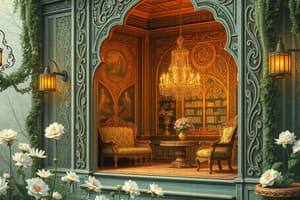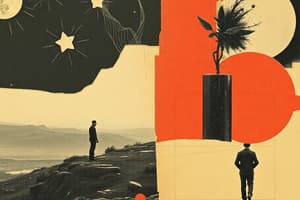Podcast
Questions and Answers
What is the purpose of exposition in a fictional narrative?
What is the purpose of exposition in a fictional narrative?
- To illustrate the story’s characters and setting
- To provide self-talk for the characters
- To depict the actions of the characters in the story
- To inform readers about the story’s characters, setting, and mood (correct)
Which narrative mode represents characters talking to one another?
Which narrative mode represents characters talking to one another?
- Monologue
- Description
- Action
- Dialogue (correct)
What aspect of fiction does the character represent?
What aspect of fiction does the character represent?
- The physical setting of the story
- The narrative voice used by the writer
- The imaginary person who breathes life into the story (correct)
- A fictional plot twist
Which narrative mode provides a way for characters to express their inner thoughts?
Which narrative mode provides a way for characters to express their inner thoughts?
How does action as a narrative mode function in a story?
How does action as a narrative mode function in a story?
What is a protagonist in the context of fiction?
What is a protagonist in the context of fiction?
Which narrative mode is primarily focused on giving details about characters and settings?
Which narrative mode is primarily focused on giving details about characters and settings?
What is a key skill a fiction writer should develop before writing a fictional text?
What is a key skill a fiction writer should develop before writing a fictional text?
What is a characteristic of first-person narrators in a story?
What is a characteristic of first-person narrators in a story?
Which type of third-person point of view shares everything about the characters, including their thoughts?
Which type of third-person point of view shares everything about the characters, including their thoughts?
What is the function of the exposition in a plot?
What is the function of the exposition in a plot?
What does the term 'In Medias Res' refer to in a plot structure?
What does the term 'In Medias Res' refer to in a plot structure?
Which plot structure consists of two or more linear plots occurring at the same time?
Which plot structure consists of two or more linear plots occurring at the same time?
What occurs during the climax of a story?
What occurs during the climax of a story?
Which of the following best describes 'man versus self' conflict?
Which of the following best describes 'man versus self' conflict?
What does falling action in a plot lead to?
What does falling action in a plot lead to?
What is the role of a deuteragonist in a story?
What is the role of a deuteragonist in a story?
Which character type is characterized by a contrasting personality to the main character but is not considered a villain?
Which character type is characterized by a contrasting personality to the main character but is not considered a villain?
How does a dynamic character differ from a static character?
How does a dynamic character differ from a static character?
What type of setting includes the geographical location and physical arrangements within a story?
What type of setting includes the geographical location and physical arrangements within a story?
Which character type has varied and contrasting traits?
Which character type has varied and contrasting traits?
What does the term ‘confidante’ refer to in the context of character types?
What does the term ‘confidante’ refer to in the context of character types?
What is characterized by the time and conditions in which the story occurs?
What is characterized by the time and conditions in which the story occurs?
What narrative style is used when the main character narrates the story?
What narrative style is used when the main character narrates the story?
What is the purpose of using allusion in literature?
What is the purpose of using allusion in literature?
Which literary device is described as the deliberate selection of words to convey a specific message?
Which literary device is described as the deliberate selection of words to convey a specific message?
What does foreshadowing accomplish in a narrative?
What does foreshadowing accomplish in a narrative?
How does an allegory function in literature?
How does an allegory function in literature?
Which literary device uses vivid descriptions to engage the reader's senses?
Which literary device uses vivid descriptions to engage the reader's senses?
In what way does a euphemism function in writing?
In what way does a euphemism function in writing?
What is the effect of alliteration in literature?
What is the effect of alliteration in literature?
What aspect sets symbolism apart from other literary techniques?
What aspect sets symbolism apart from other literary techniques?
What is the conflict described as 'Man versus nature'?
What is the conflict described as 'Man versus nature'?
Which type of conflict involves the protagonist against someone with abilities beyond human nature?
Which type of conflict involves the protagonist against someone with abilities beyond human nature?
What does 'theme' in literature represent?
What does 'theme' in literature represent?
What is an example of personification from the given options?
What is an example of personification from the given options?
Which of the following is an example of alliteration?
Which of the following is an example of alliteration?
In what type of conflict does the protagonist grapple with a product of technology?
In what type of conflict does the protagonist grapple with a product of technology?
What literary device is exemplified when describing 'Her eyes were as large and bright as the moon'?
What literary device is exemplified when describing 'Her eyes were as large and bright as the moon'?
Which of the following illustrates an onomatopoeic expression?
Which of the following illustrates an onomatopoeic expression?
Flashcards are hidden until you start studying
Study Notes
Fiction’s Foundation
- Fiction often draws from real life, even if it portrays imaginary world events and people
- Before writing fiction, understanding its elements is crucial to create persuasive and inspiring imaginary worlds
Learning Goals
- Identify narrative modes in fiction
- Analyze elements of fiction
- Write fictional texts with different elements and narrative modes
Narrative Modes in Fiction
- Exposition: Introduces readers to the story's characters, setting, and mood
- Action: Allows characters to move and act within the story
- Description: Illustrates the story's characters, setting, and objects
- Monologue: Presents self-talk within the narrative
- Dialogue: Embraces conversations between characters in the story
Elements in Fiction
- Character: An imaginary person who gives life to the story
- Types of Characters:
- Protagonist: Central character in the story
- Antagonist: Opposes or contradicts the protagonist
- Deuteragonist: Second most significant character in the story
- Confidante: Close friend of the protagonist
- Foil: Shows traits contrasting the protagonist's character, but is not the villain
- Love Interest: Character the protagonist has romantic feelings for
- Tertiary or Background: Characters not directly connected to the primary storyline
- Dynamic: Character whose personality changes throughout the story
- Static: Character whose personality remains unchanged
- Round: Character with diverse and contrasting traits
- Flat: Character with a single personality
- Types of Characters:
- Setting: Time, place, and conditions where the story takes place
- Types of Setting:
- Geographical Location: Topography, scenery, physical arrangements
- Occupations: Characters' work and daily routines
- Time or Period: When the action takes place
- General Environment: Religious, mental, moral, social, and emotional conditions
- Types of Setting:
- Point of View: Narration or the narrator's perspective
- Types of Point of View:
- First Person: Narrated by the main character (or one character), multiple characters can narrate leading to a multi-person point of view
- Second Person: The narrative focuses on the reader
- Third Person: Narrated by an outsider observer of the story
- Types of Third Person Point of View:
- Limited: Narrator shares actions and speech of the characters
- Omniscient: Narrator reveals everything about the characters, including thoughts and feelings
- Types of Point of View:
- Plot: Arrangement of events and actions in a story, not always chronological
- Types of Plot:
- Linear: Chronological order of events
- Episodic: Series of connected incidents that form a larger plot
- Parallel: Two or more simultaneous linear plots
- Circular: Starts and ends similarly
- In Medias Res: Starts in the middle of the story
- In Extrema Res: Starts at the end of the story
- Plot Elements:
- Exposition: introduces characters, setting, and mood
- Rising Action: Incidents leading to the complication
- Climax: Highest point of tension and conflict resolution
- Falling Action: tension decreases and issues are solved
- Resolution: Conclusion where the main problem is resolved
- Types of Plot:
- Conflict: Struggle present within the story
- Types of Conflict:
- Man versus self: Internal struggle within the protagonist
- Man versus man: Protagonist vs. another person
- Man versus nature: Protagonist vs. natural forces
- Man versus the supernatural: Protagonist vs. entity with supernatural abilities
- Man versus technology: Protagonist vs. technology
- Man versus society: Protagonist vs. a social group
- Types of Conflict:
- Theme: Unifying idea or statement in the story
Techniques and Devices in Fiction
- Allusion: Refers to mythological, literary, historical, biblical, scientific, or political figures, events, places, or objects to represent something.
- Diction: Careful selection of words and phrases to convey a message.
- Alliteration: Repetition of initial sound or letter in a string of words.
- Allegory: Story or element within a story conveying a message about real-world issues/events.
- Euphemism: Using a word or phrase as a softer alternative to a harsh or taboo term.
- Flashback: Interrupts chronological events to narrate past events.
- Foreshadowing: Hints are given to events that will happen later in the narrative.
- Imagery: Uses descriptive language to create a picture in the reader's mind, affecting their senses and emotions.
- Symbolism: Someone/something represents an emblematic or abstract meaning.
Studying That Suits You
Use AI to generate personalized quizzes and flashcards to suit your learning preferences.




